ACE’s new Senior Fitness Manual consolidates all of the latest research for those who train the active aging market. While there are three primary groups of people over the age 50—fragile, healthy and elite—this article focuses on the healthy group—the independent, self-efficacious individuals capable of standing and walking.
Almost every chapter of the ACE manual recommends that all individuals engage in some cardiovascular, strength/endurance, flexibility and balance movements on most days of the week. These should include the following movement types: single leg (like walking), pushing, pulling and twisting (American Council on Exercise, 2015). Additionally, some mental training can accompany this type of activity to add the important aspect of neuroplasticity training to the entire regime (Adams, 2007). Neuroplasticity training involves adding a mental component to physical movement from one or more of the following skills: short- and long-term memory, math, spatial skills, language and problem solving (Lyubomirsky, 2011).
The following workout takes less than 30 minutes to complete and includes some of the best movements for improving most of these aforementioned physical and mental activities of daily life with the active aging population. If any particular task proves too difficult, skip it and focus only on your participants’ successes.
1. Walkie-Talkie for cardiovascular and neuroplasticity for spatial, language and memory skills (5 minutes)
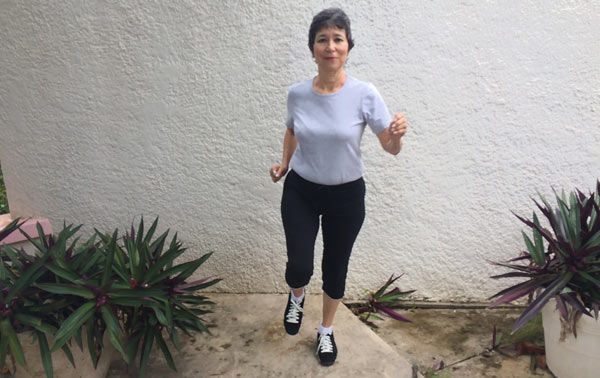
Stand and march in place, moving arms front and back simultaneously, choosing knee height and intensity based on the client’s needs and abilities. If possible, have the client walk around the area in looping patterns, making a figure “8.” During this time, have the client recite his or her telephone number out loud and then recite the number backward a few times. After a few attempts, have the client spell out loud his or her favorite color, both forwards and backwards. If you choose a simple color like “red,” try “turquoise” and “fuchsia.” Finally, have the client return to reciting his or her phone number backwards or add the digits of the phone number, adding one digit each time, to finish with one grand sum (Figure 1).
2. Push-and-pull for strength/endurance with neuroplasticity for problem-solving and math skills (5-7 minutes)
Section 1: “Push.”
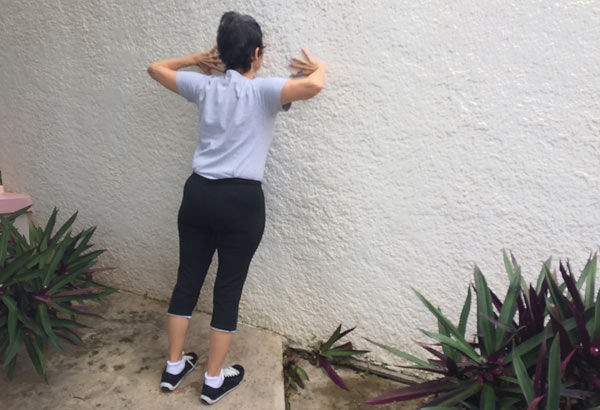
Stand at a wall at least about two feet away. Place the hands on the wall about chest height, fingers of each hand facing each other or pointing forwards for push-ups, and elbows extended. Slowly lower the upper body toward the wall so the nose almost touches it, and repeat to standing position on an exhalation. Repeat up to 15 times.
Section 2: “Pull.”
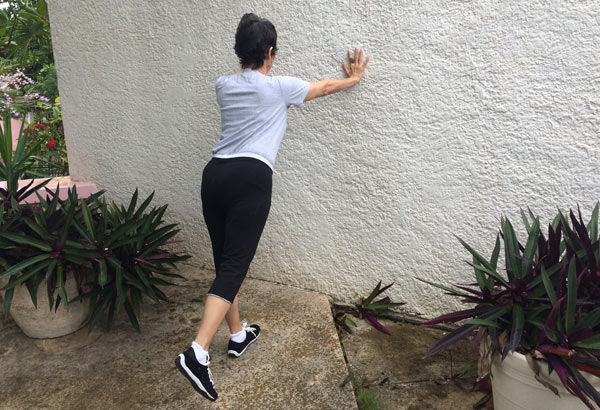
With the right knee extended, pull it back with the gluteus maximus (hip extension) until the buttocks tighten; repeat up to 15 times. Maintain a neutral spine, keep the toes pointing toward the wall (avoiding external rotation), and exhale during the pulling phase. Repeat with the other leg.
Cycle these “Push” and “Pull” moves until the client has finished three sets of each. When counting repetitions out loud (working backward from 15), have the client spell out each number each time, during each repetition (Figures 2.1 and 2.2).
3. Rotation for obliques with neuroplasticity for problem solving, spatial and short-term memory skills (2-3 minutes)
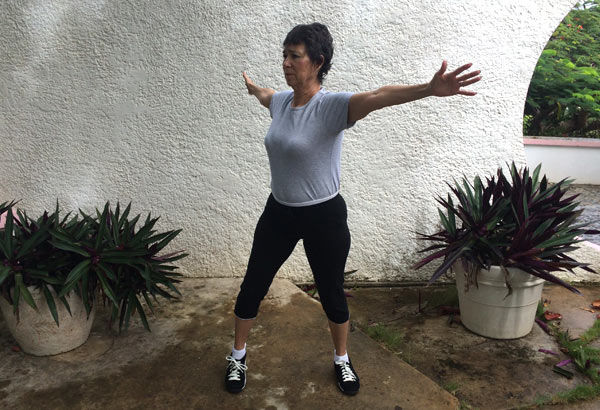
Stand with feet slightly wider than hip-distance apart. Abduct the shoulders so arms are parallel to floor (like airplane wings). Raise the right heel and turn the entire body slowly to the left, and return. The left foot stays stationary. Repeat on the other side. Cycle this slowly for two to three minutes. Be sure to keep a neutral cervical spine during the process. With each repetition, have the client repeat different sections of the alphabet (7 letters each time) both forward and backward. For example, recite “a” through “g” forward and backward, and then start with “h” through “n.” Start any repetition set with any letter between “a” and “t” (Figure 3).
4: Standing hip hikes to strengthen the stabilizing quadratus lumborum in the frontal plane (3-5 minutes)
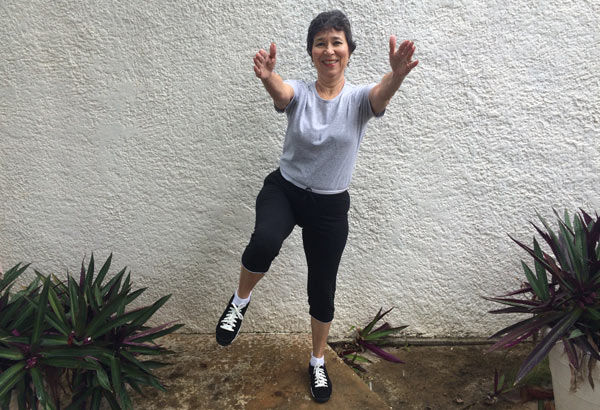
Stand on the left leg with arms out in front, parallel to the floor (like a “zombie”). Slowly hike the right hip as far as possible and then return to the starting position. Lower only the toes to the floor between repetitions. Repeat up to 15 times and switch sides. Keep the shoulders level as if balancing a glass of water on each one. Use a mirror to self-correct, and hold a chair or wall if necessary. Continue cycling sides until finishing three sets on each leg (Figure 4).
Section 5: Single-leg bridges to strengthen the lumbo-pelvic complex unilaterally in the sagittal plane with neuroplasticity for short-term memory (3-5 minutes)
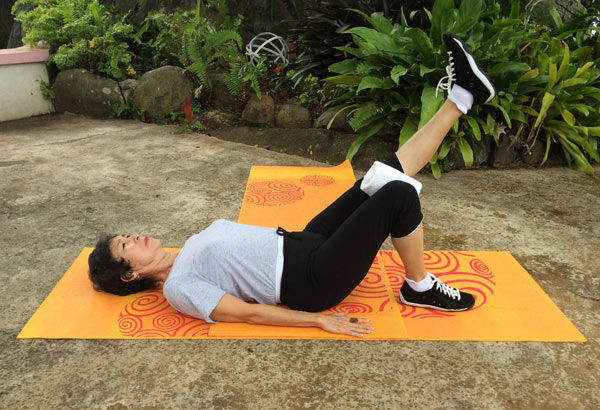
Lay supine with the knees flexed, feet flat on the floor, and both hips and knees hip-width apart. Keep the hands on the floor next to the hips, palms down. If necessary, place a small ball or folded towels between the knees to keep spacing. Extend the right knee as far as possible without locking it. Press the hands, feet and shoulders into the floor gently and lift (extend) the hips into bridge position with an exhalation; lower back down. Repeat up to eight times and then switch sides. Continue cycling sides to complete three sets on each leg (Figure 5).
Instead of counting repetitions, have the client make a grocery list of his or her favorite foods with each repetition. On the first hip lift, for example, say “chocolate.” On the second repetition, repeat “chocolate” and then add one more food. Finish the remaining repetitions, adding one more food with each until there are eight items on one side on the eighth repetition. On the second side, repeat the same list, but in a different order.
To be sure, active aging workouts can be as varied as the people that partake in them. That said, some of the most functional training programs include not only an important physical component, but a mental component of neuroplasticity as well to guarantee the most benefits per training session (Rogers, 2005). When we train the mind along with the body, we help train the body in the most complete manner, helping to guarantee, not active “seniors,” but true champions of living.
References
Adams, T. et al. (2007). The relationship between physical activity and mental health in a national sample of college females. Women and Health, 45, 1, 69-83.
American Council on Exercise (2014). ACE Senior Fitness Manual, 1st ed. San Diego, Calif.
Lyubomirsky, S. et al. (2011). Becoming happier takes both a will and a proper way: An experimental longitudinal intervention to boost well-being.
Emotion, 11, 2, 391-402.
Rogers, M.E. (2005). Pre-exercise and health screening. In C. J. Jones and D. J. Rose (Eds.), Physical Activity Instruction of Older Adults. Champaign, Ill.: Human Kinetics, Inc.




 by
by 






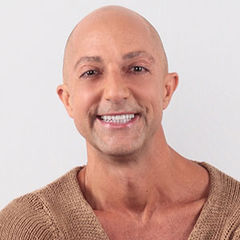


 by
by